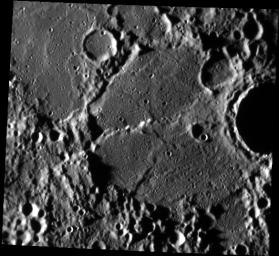In order to determine the sequence in which events occur on a planetary surface, scientists study the relationships between surface features. In this image, there are two major relationships that help us understand how this landscape formed. The crater to the right (interior is shadowed) is sitting on top of the larger, filled crater that takes up most of the scene. Because it sits on top, it must be younger. Scientists call this the Law of Superposition. If we look at the large, filled crater itself, we see that it has been altered by the formation of a scarp. Because the scarp altered the basin, the scarp must also be younger. This is called the Law of Cross-cutting Relationships.
This image was acquired as part of MDIS's high-incidence-angle base map. The high-incidence-angle base map is a major mapping activity in MESSENGER's extended mission and complements the surface morphology base map of MESSENGER's primary mission that was acquired under generally more moderate incidence angles. High incidence angles, achieved when the Sun is near the horizon, result in long shadows that accentuate the small-scale topography of geologic features. The high-incidence-angle base map is being acquired with an average resolution of 200 meters/pixel.
Date acquired: August 29, 2012
Image Mission Elapsed Time (MET): 254709805
Image ID: 2479688
Instrument: Narrow Angle Camera (NAC) of the Mercury Dual Imaging System (MDIS)
Center Latitude: -20.12°
Center Longitude: 85.74° E
Resolution: 217 meters/pixel
Scale: The large, filled crater is approximately 78 km (48 mi.) in diameter.
Incidence Angle: 85.3°
Emission Angle: 23.8°
Phase Angle: 61.4°
The MESSENGER spacecraft is the first ever to orbit the planet Mercury, and the spacecraft's seven scientific instruments and radio science investigation are unraveling the history and evolution of the Solar System's innermost planet. Visit the Why Mercury? section of this website to learn more about the key science questions that the MESSENGER mission is addressing. During the one-year primary mission, MDIS acquired 88,746 images and extensive other data sets. MESSENGER is now in a year-long extended mission, during which plans call for the acquisition of more than 80,000 additional images to support MESSENGER's science goals.
These images are from MESSENGER, a NASA Discovery mission to conduct the first orbital study of the innermost planet, Mercury. For information regarding the use of images, see the MESSENGER image use policy.

 Planetary Data System
Planetary Data System












